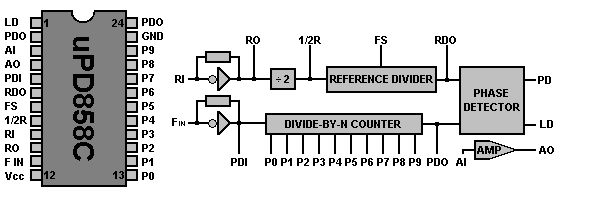| Pin | Name | Decription |
|---|
| 1 | LD | Loop Detector output - HIGH=Unlocked LOW=Locked |
| 2 | PD out | Phase Detector output |
| 3 | AI | Loop filter Amplifier Input |
| 4 | AO | Loop filter Amplifier Output |
| 5 | PDI | Programable Divider Input |
| 6 | RDO | Reference Divider Output |
| 7 | FS | Frequency Select input: HIGH= 10kHz - LOW=5kHz |
| 8 | 1/2R | Referency frequency divided by 2 |
| 9 | RI | Referency oscillator Input (X-tal) |
| 10 | RO | Refeerency oscillator Output (X-tal) |
| 11 | FIN | VCO Oscillator Input |
| 12 | VCC | Positive Power Supply (+5Volt) |
| 13 | P0 | BCD programable input 0 |
| 14 | P1 | BCD programable input 1 |
| 15 | P2 | BCD programable input 2 |
| 16 | P3 | BCD programable input 3 |
| 17 | P4 | BCD programable input 4 |
| 18 | P5 | BCD programable input 5 |
| 19 | P6 | BCD programable input 6 |
| 20 | P7 | BCD programable input 7 |
| 21 | P8 | BCD programable input 8 |
| 22 | P9 | BCD programable input 9 |
| 23 | GND | Ground |
| 24 | PO | Programable Divider Output |




